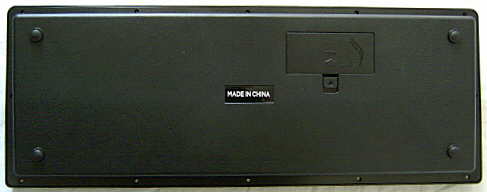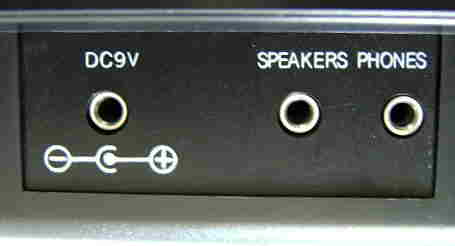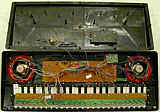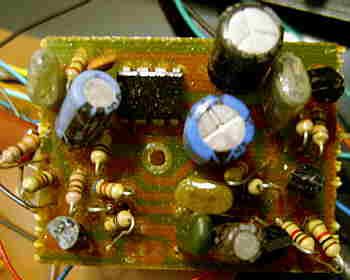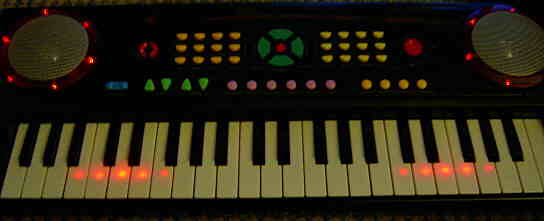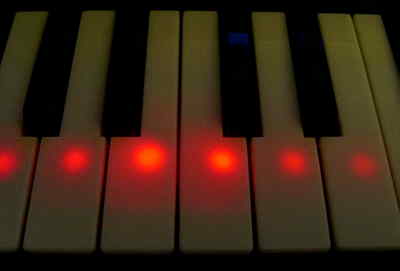 |
|
|
lo-fi
keyboard with key lighting, many nice demos & programmable rhythm |
|
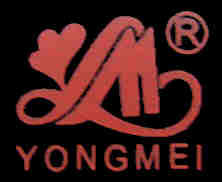 |
This toy tablehooter has a very similar case like the SongMax
HMP-138, but additional key lighting, programmable rhythm and main
voice sound based on My Music Center
hardware.
The infamous Yongmei keyboards are obviously getting better; this
one contains no such extreme cable mess anymore, and it fortunately now
also has battery decoupling diodes (on a tiny separate PCB) to prevent
the batteries from turning into handgrenades when operated through a power
supply (see
Golden Camel 7A and
-11AB).
But the sound still distorts badly during polyphonic play; apparently the
amplifier is poorly designed.
There are 12 OBS sounds with the characteristic glassy My
Music Center chorus timbres; the vibrato button disables the chorus
effect and adds a fast square vibrato, and there is also a sustain button.
Unfortunately the instrument is only 2 note polyphonic and turns monophonic
when rhythm is activated. The 12 OBS rhythms have each an optional bass
line accompaniment (resembling Feng Yuan
28061) with selectable timbre; unfortunately it plays in a fixed
key and thus is badly suited for melody play. There are also 4 drumpads
with a programmable drum pattern (without accompaniment). The white keys
have dim red LEDs underneath for key lighting; during rhythm they make
complex walking light patterns and also the speakers are encircled by 2
spinning red lights so long any sound plays. There are 22 nicely made demo
melodies usable for key lighting, and the key lighting is more complex
than with older My Music Center variants. A small keyboard flaw
sometimes skips notes during fast polyphonic play (despite the pressed
keys light up correctly), but it is way less severe than with other such
instruments, because it only occurs with really fast notes (possibly when
temporary more than 2 keys are pressed, which makes it run out of polyphony).
According to the box photo also a silver version of the Yongmei
YM-238C was made. On the box a monochrome magenta sticker covered the
writing "Try Me, Press Button",  thus
likely the box was originally planned to have a punched out front opening
like with SongMax HMP-138. My
specimen also has a sticker of the German importer: "Müller Consult
I/E Gmbh, 13156 Berlin" and stickers with a german feature list. Unlike
certain older Yongmei keyboards, there are also no lies or false
claims on the box anymore, only some funny Engrish misspellings. Who knows
what this gibberish sentence on the stylish box wants to tell us?!?: "On
the packing the color of product picture describes with function, pleasing
regard real object as to allow!" - another one: "Music of Song Withstand
Microphone Included". thus
likely the box was originally planned to have a punched out front opening
like with SongMax HMP-138. My
specimen also has a sticker of the German importer: "Müller Consult
I/E Gmbh, 13156 Berlin" and stickers with a german feature list. Unlike
certain older Yongmei keyboards, there are also no lies or false
claims on the box anymore, only some funny Engrish misspellings. Who knows
what this gibberish sentence on the stylish box wants to tell us?!?: "On
the packing the color of product picture describes with function, pleasing
regard real object as to allow!" - another one: "Music of Song Withstand
Microphone Included". |
main features:
-
44 midsize keys (naturals have red key lighting)
-
2 built- in speaker (8cm, bassless and harsh distorting with unpleasant
midrange resonance, mono)
-
main voice polyphony 2 notes (only 1 with rhythm, a small keyboard flaw
sometimes skips notes during very fast polyphonic play)
-
12 OBS preset sounds {piano, organ, violin, trumpet, mandolin, bell, music
box, guitar, sax, oboe, bass, harp}
-
12 OBS preset rhythms {waltz, bossanova, chacha, disco, march, rock, rumba,
swing, tango, belero, newnew, blues}
-
vibrato & sustain button
-
volume +/- buttons (8 steps)
-
tempo +/- buttons (22 steps)
-
fixed key bassline accompaniment (toggled on/ off by "chord" button)
-
"chordinst" button cycles through many accompaniment timbres
-
4 drumpad buttons {base, snare, closed cymbal, open hihat} (switchable
to "samba" drum pattern mode)
-
programmable drum pattern (monophonic)
-
simple sequencer (record & play of 74 notes, no edit, quite useless
because contents is erased as soon anything but "play" is pressed).
-
sound generator like Feng Yuan 28061
(variant of My Music Center)
-
CPU "?89E, ZT" (COB module)
-
red flashing speaker rim LEDs
-
key light on/ off button
-
key lighting (2 modes)
-
22 demo melodies (nice polyphonic orchestrations)
-
auto power- off
-
came with plastic microphone and note stand
-
jacks for AC-adapter, microphone (mislabelled "phones") and speakers
 |
 |
eastereggs:
-
"chord" button enters a pause during rhythm programming.
notes:
The behaviour and sounds of this instrument have many similarities with
the small Feng Yuan 28061; even
the preset sound names match. Like there, all buttons beep with rhythm
off, and the OBS preset buttons play their sound when pressed (even during
rhythm), which disturbs live performance. The start- up jingle is a tone
scale (do re mi fa so la ti do) accompanied by some low notes. The sound
distorts quite harshly especially during polyphonic play, which is here
not caused by a faulty speaker but seems to be an amplifier design flaw.
Like with other Yongmei keyboards, the amp is on a small and messy
separate PCB with an IC and many discrete components. Unfortunately it
also sounds thinner like the Feng Yuan. The volume can not be set
lower than medium room volume. The walking light patterns on the keys during
rhythm and demos look impressive, although they are not synchronized to
the music in any way. Unfortunately they cause some static hum (like mains
hum) of varying intensity, which is especially noticeable when volume is
set low, but at least the light can be disabled.
The preset sound set is a cross of the My
Music Center and the Feng Yuan
28061 sounds. By their detuned chorus component they don't sound
realistic, although most are closer than with Feng Yuan 28061. The
sounds "piano", "organ", "violin", "mandolin", "bell", "guitar" are very
much like with My Music Center. The "trumpet" is less harsh than
there. With "musicbox" the chorus tremolo speed drastically varies with
the note pitch (the higher, the faster, like with Feng Yuan 28061).
This timbre is quite unique and eerie; especially when 2 close notes are
played simultaneously, the distortion intermodulates their chorus in a
very weird bubbling way. The resulting sound reminds to knocking on a water
filled ceramic jug or the like. The "sax" timbre sounds too thin for a
saxophone. Also the "oboe" is rather like the squawky "elec organ" on Casio
SA-series than an oboe. The "bass" is more a banjo and decays shorter
with held keys. The harp is similar (without that decay paradox) and duller.
The vibrato button disables the chorus component (mutes one suboscillator)
and adds a 6Hz square vibrato. The "sax", "oboe", "bass" and "harp" sound
more realistic by this disabled chorus. The sustain button adds a 2s sustain.
The rhythm and accompaniment style sounds much like with Feng Yuan
28061; unfortunately it lacks the nicely grooving "samba" pattern.
The OBS rhythm buttons always (re-) start their rhythm with enabled bass
accompaniment and default tempo, but at least they immediately start a
pattern, which can be used for life play tricks. The accompaniment is only
a monophonic bass line; its sound has no chorus suboscillator; timbre and
decay rate depends on the preset rhythm. During rhythm the accompaniment
can be rapidly toggled on/ off with the "chord" button, and the "chordinst"
button cycles through many sounds (although with some rhythms it does not
return to the initial timbre). This can be done in realtime (both buttons
don't beep), which despite the limited control almost feels a bit like
making acid house music. Like with My Song
Maker, the drumpads can be also switched into "samba" mode, where
a dedicated preset rhythm starts (without accompaniment) and each pad plays
a preset drum pattern.
Like with Feng Yuan 28061, there is a programmable drum
pattern (custom drummer, similar like with Letron
MC-3), but this one is far more restricted, because once the user
pattern is entered (press "program" button, play on drumpads or "chord"
button for pause, then "play" to finish), it starts immediately and can
not be stopped again without deleting the pattern. The only thing you can
do with it is restarting the pattern from step 1 by pressing "play". There
is no accompaniment in this mode.
For demo and key lighting there are 22 nicely orchestrated demo melodies:
-
Feece
-
Happy Birthday
-
Song of Joy
-
Go Home [= "Unterlanders Heimweh" (the Casio
MT-36 tune, not the VL-Tone
one)]
-
Row the Boat
-
Joy to the World
-
Clementine
-
Say Hello
-
Golden Dream
-
Cheerful Race
-
Cherry Flower
-
Relative in Hometown
-
London Dl. Ditty Minor
-
Spring is coming
-
Santa Lucia
-
In the beautiful grass
-
In the forest and grass
-
Little Red Hat
-
Oh Tannenbaum
-
Swallow
-
Dusk
-
Two Tigers
The white keys have red LEDs for key lighting. Unlike older key lighting
instruments of the My Music Center hardware family, the key lighting
is more complex designed, thus the following note key flashes like with
Casio
keyboards. The "guide a" mode is simply a one key play mode; while key
lighting shows the correct notes, the melody plays always the correct note
independent from the pressed keys. Like with My Song Maker, with
no pressed keys the accompaniment track repeats in a loop, which can be
abused for tekkno patterns. The "guide b" mode behaves quite unique (different
from Casio); the instrument first plays with key lighting a pattern
of the melody, then you have to replay it manually (at any speed). When
you play right, it continues with showing the next pattern, otherwise all
keys flash with a hihat noise and you have to try again that pattern until
you play right.
A successor of this instrument with even more spectacular light effects
was released as Sound Mixer HMP-288.
| removal
of these screws voids warranty... |
|
|
 |

|
|
| |
back
|
|




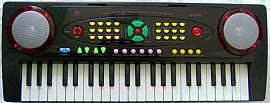
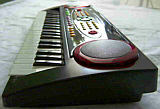
 thus
likely the box was originally planned to have a punched out front opening
like with SongMax HMP-138. My
specimen also has a sticker of the German importer: "Müller Consult
I/E Gmbh, 13156 Berlin" and stickers with a german feature list. Unlike
certain older Yongmei keyboards, there are also no lies or false
claims on the box anymore, only some funny Engrish misspellings. Who knows
what this gibberish sentence on the stylish box wants to tell us?!?: "On
the packing the color of product picture describes with function, pleasing
regard real object as to allow!" - another one: "Music of Song Withstand
Microphone Included".
thus
likely the box was originally planned to have a punched out front opening
like with SongMax HMP-138. My
specimen also has a sticker of the German importer: "Müller Consult
I/E Gmbh, 13156 Berlin" and stickers with a german feature list. Unlike
certain older Yongmei keyboards, there are also no lies or false
claims on the box anymore, only some funny Engrish misspellings. Who knows
what this gibberish sentence on the stylish box wants to tell us?!?: "On
the packing the color of product picture describes with function, pleasing
regard real object as to allow!" - another one: "Music of Song Withstand
Microphone Included".

